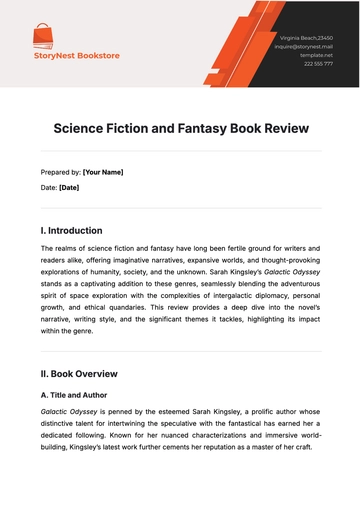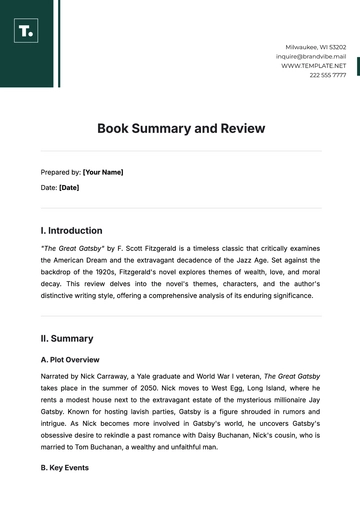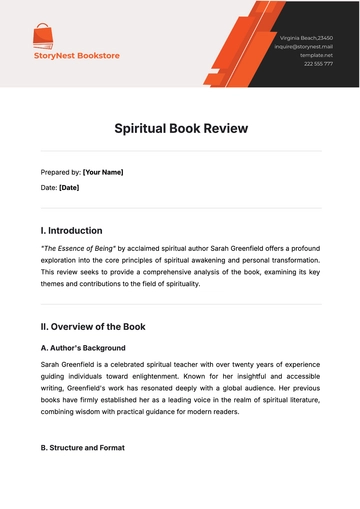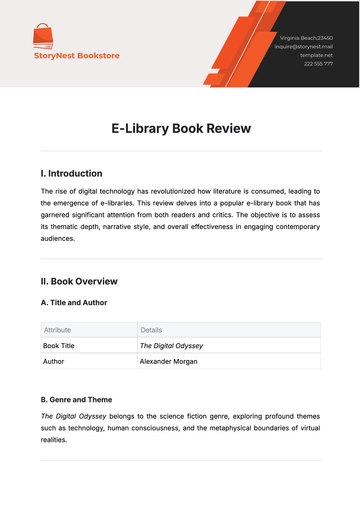Free Business Book Review

Prepared by: [Your Name]
Company: [Your Company Name]
Date: [Date]
I. Introduction
This review presents a comprehensive analysis of "Mastering Business Strategies: A Roadmap to Success," a groundbreaking book that offers valuable insights into various business strategies and practices. This book serves as an indispensable guide for entrepreneurs, business leaders, and students of business management, providing both theoretical frameworks and practical applications for thriving in the modern business environment.
II. Overview of Content
A. Author Background
The book is authored by Davion Barton, a globally recognized business strategist and thought leader with over two decades of experience in the corporate world. As the founder of several successful ventures, his career spans leadership roles in multinational companies, and he has advised Fortune 500 businesses on strategic development. His deep expertise and hands-on experience are reflected in the way he presents complex business concepts in a clear and engaging manner.
B. Structure and Organization
The book is thoughtfully structured, and divided into ten chapters that explore various facets of business strategy. Each chapter tackles a critical element of business success, ranging from the foundational principles of strategic planning to advanced techniques in leadership, marketing, and financial management. The logical progression of topics ensures that readers can absorb the information step by step, building a comprehensive understanding of effective business practices.
III. Key Themes and Concepts
A. Theme 1: Strategic Planning
Strategic planning is one of the central themes of the book. The author emphasizes the significance of setting clear, measurable objectives and aligning resources accordingly. He introduces several models, including the SWOT analysis and Porter’s Five Forces, that are essential for evaluating market opportunities and positioning businesses effectively in competitive environments.
B. Theme 2: Leadership and Management
The book offers an in-depth exploration of leadership and management styles. Key sections include:
Leadership Styles: The author discusses different leadership approaches, such as transformational and servant leadership, and explains when and how each can be applied.
Team Building: Strategies for building cohesive, high-performing teams are covered extensively, with advice on fostering collaboration and trust within organizations.
Decision Making: A dedicated section on decision-making frameworks helps readers understand how to make well-informed, data-driven decisions that contribute to long-term business success.
C. Theme 3: Marketing and Customer Engagement
Marketing and customer engagement are highlighted as critical factors in any business strategy. The author provides actionable steps for identifying customer needs, creating customer personas, and developing tailored marketing campaigns. A special focus is placed on digital marketing and how businesses can leverage social media and content marketing to engage modern consumers effectively.
IV. Notable Chapters
A. Chapter 3: Innovation in Business
Chapter 3 explores the concept of innovation as the key to long-term success in business. The author stresses that innovation goes beyond product development and includes innovative business models, processes, and customer engagement strategies. Numerous case studies, such as Apple’s product innovation and Amazon's disruptive e-commerce strategies, are used to illustrate real-world applications of innovation.
B. Chapter 7: Financial Management
In Chapter 7, the author delves into the essentials of financial management. The chapter covers a wide range of topics, including:
Budgeting: How to create and manage budgets that reflect business priorities.
Financial Forecasting: Techniques for predicting future financial outcomes and adjusting strategies accordingly.
Investment Strategies: Insights into making sound investment decisions to support growth and long-term profitability.
V. Strengths and Weaknesses
A. Strengths
Clear and Concise Writing Style: The author's ability to simplify complex business concepts without losing their essence makes the book accessible to both beginners and experienced business professionals.
Rich with Real-World Examples: The book is filled with case studies, anecdotes, and success stories from companies such as Google, Starbucks, and Tesla, providing practical insights into how theories play out in real business scenarios.
Practical Tools and Frameworks for Implementation: Readers will appreciate the inclusion of various strategic tools and frameworks that can be directly applied to their businesses.
B. Weaknesses
Some Concepts Are Overly Simplified: While the book is accessible, some of the concepts, especially in advanced topics like corporate governance and international business strategy, could have been explored in more depth.
Lacks Depth in the Latest Digital Marketing Trends: Given the rapid evolution of digital marketing, the book doesn’t delve deeply into newer trends such as AI-driven marketing or voice search optimization, which would have added value for modern business leaders.
VI. Conclusion
Overall, "Mastering Business Strategies: A Roadmap to Success" is a valuable resource for anyone looking to enhance their business acumen. Its blend of practical advice, real-world examples, and easy-to-understand frameworks makes it an essential read for both aspiring entrepreneurs and established business professionals. The book’s clear focus on strategy, leadership, and customer engagement provides readers with the knowledge needed to navigate today’s competitive business landscape.
VII. Table of Key Business Strategies
Strategy | Description | Application |
|---|---|---|
SWOT Analysis | Assess strengths, weaknesses, opportunities, and threats. | Helps businesses identify strategic priorities and risks. |
Porter's Five Forces | Analyze market competition and industry structure. | Guides businesses in crafting competitive strategies. |
Customer-Centric Marketing | Tailor marketing efforts based on customer needs and behaviors. | Improves customer engagement and conversion rates. |
Lean Startup Model | Use iterative product development and validated learning. | Helps new businesses innovate quickly with minimal resources. |
Financial Forecasting | Predict future revenues and expenses to guide business decisions. | Essential for effective budgeting and long-term planning. |
- 100% Customizable, free editor
- Access 1 Million+ Templates, photo’s & graphics
- Download or share as a template
- Click and replace photos, graphics, text, backgrounds
- Resize, crop, AI write & more
- Access advanced editor
The Business Book Review Template from Template.net offers a fully editable and customizable design to streamline your book review process. Tailor the template to fit your needs, whether for personal or professional use. Easily edit and update content using our AI Editor Tool, making it the perfect solution for efficient and polished book reviews.




























